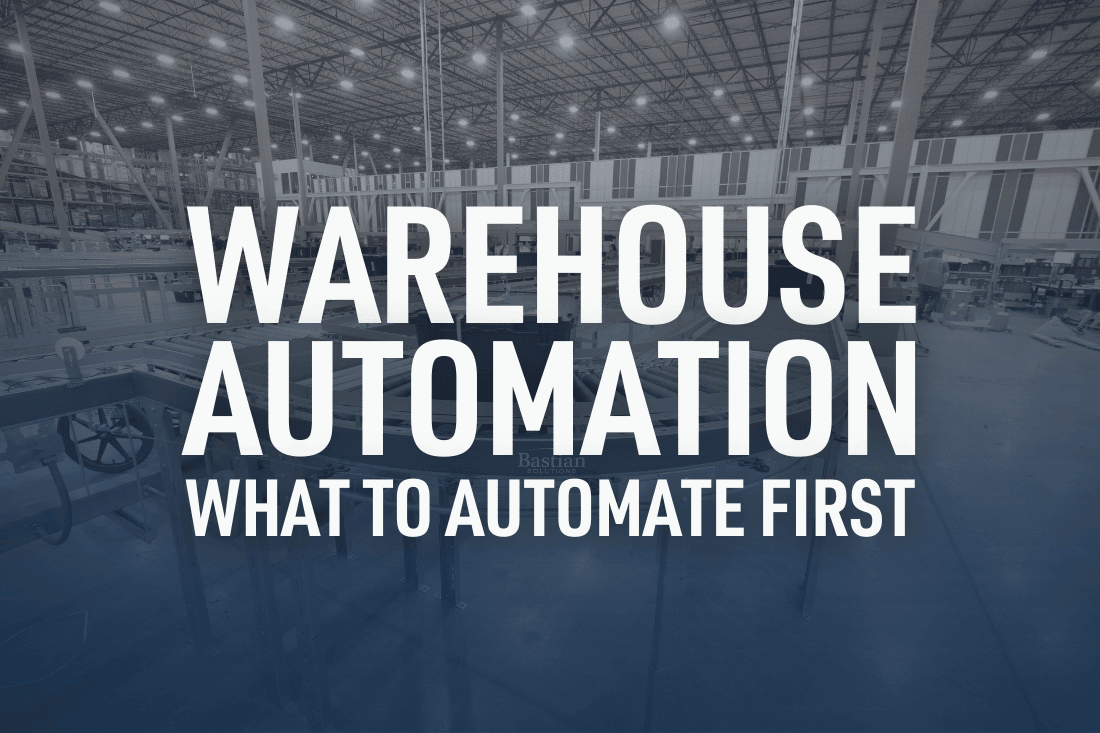5 min read
Warehouse Automation: What to Automate First and Why
![]() Boone Faulkner
Sep 26, 2025 8:00:00 AM
Boone Faulkner
Sep 26, 2025 8:00:00 AM

Imagine you’re putting together a jigsaw puzzle.
There are several ways you could start. You could begin by sorting the pieces by color, or seeking out edges and corners, or you could look for patterns and pair them together. No method is the one right answer.
Adding automation to your warehouse for the first time is a lot like starting that jigsaw puzzle.
There are a ton of available options with numerous pieces that must fit together cohesively. Likewise, there is no “correct” first automation solution. However, there are tactics you can take to find the best starting place for you and your organization.
Read on to learn:
- What challenges an automated warehouse solves
- How to choose what to automate first
- What to keep in mind when selecting your first automated solution
Benefits of Warehouse Automation
The first question of any automation journey should be, "Can automation solve our problem?"
There's much that automation can do, and the list grows every year. Consequently, it's impossible to make a truly comprehensive list of tasks suited for automation. However, automation generally provides several broad benefits.
Here are four such advantages that benefit most warehouses.
- Increased productivity. Repetitive, low-value tasks are a time sink and, therefore, a productivity killer. For example, a typical worker in an analog warehouse wastes 60% of their day walking the floor. Automation handles these tasks, meaning your team wastes less time and adds more value.
- Reduced errors. The average person makes about 50 mistakes a day. This error rate increases when associates are tired or bored. Automation fixes that. Warehouse picking robots, for instance, don’t get fatigued, bored, or distracted. Technologies like this easily tackle tedium, reducing human error.
- Associate retention. Most workers start off highly motivated. When they're learning a new job, there are lots of little challenges to keep them engaged. However, experience can make some tasks so routine that they become trivial. The boredom that spawns from this reduces job satisfaction and leads to higher turnover.
Automation keeps human workers focused on problem-solving and improves their working environments. Researchers from the McKinsey Global Institute actually found that automated warehouses had an easier time with recruitment and retention because of these factors.
- Labor solutions. Warehouse and manufacturing labor shortages are an ongoing issue that is likely to continue based on recent polls of people entering the workforce. Consequently, growing operations are frequently asked to do more with less. With limited human resources, automation can fill the gaps while maintaining your current staff. Indeed, automation does not replace workers. It helps keep revenue growing so that you can continue to employ your most valuable assets.
If any of the above would help solve the challenges you’re facing, then automation might be for you.
Deciding What To Automate First
If you’ve decided to road map automation integration, the next question is “what do we automate first?”
As referenced in the jigsaw puzzle analogy above, there is no one correct answer. Instead, the decision requires a global view of your warehouse’s needs, priorities, and current processes. One common pitfall of automation integration is to focus on a singular process or task without understanding how it fits into the larger ecosystem of your warehouse.
The only way to succeed is to take a big picture view.
Data Collection and Work Analysis
 Just like a jigsaw puzzle, you must collect all the pieces and fit them together if you want to see the big picture.
Just like a jigsaw puzzle, you must collect all the pieces and fit them together if you want to see the big picture.
That means data collection and analyzing current workflow. Spend time shadowing associates throughout their daily tasks. Focus on understanding what they are doing and why they are doing it.
Capture the time each stage of each task requires. For example,
- How much time is spent walking between stations?
- How much time does it take to check a pick list?
- How long does the actual picking take?
This data shows what tasks take up the most time while adding the least value.
In addition to the human element, map the flow of goods through your facility. Examine how inventory enters your warehouse, how it is documented in your WMS, where it is stored, and how often it is retrieved. Even a basic understanding of this flow will help you find bottlenecks and other opportunities for improvement via automation.
Data collection can be difficult, but the better your initial data, the better your result.
Green Flags for Task Automation
 Data collection will provide a variety of automation opportunities, but it’s unlikely to single out one best place to start.
Data collection will provide a variety of automation opportunities, but it’s unlikely to single out one best place to start.
To narrow the field, examine the list for tasks that lend themselves to automation. Jobs with heavy physical demands, hazardous conditions, or high injury risk are often strong candidates. Automating these tasks—with AGVs, for example—protects your staff from risks like over-exertion injuries and falls while also reducing labor costs.
Jobs like scanning, labeling, or any continuously repetitive action are also good choices.
Not only are these tedious, automated warehouse systems complete them more efficiently than their human counterparts. Additionally, any repetitive physical action puts your staff at risk of repetitive stress injuries. Thus, automation reduces workers' compensation claims for these sorts of injuries as well.
Ultimately, you should look for tasks that improve your warehouse efficiency while also improving working conditions for your human staff.
Professional Evaluation
Collecting all the above information can be a challenge, especially if you are new to automation.
That’s where working with a trusted automation partner makes all the difference. Our team of experts can help you identify which tasks to automate by examining your processes and data. With our assistance, you can maximize your ROI, increase efficiency, and excite your team.
There’s no need to forge ahead alone when you have help you can depend on.
Choosing the Best Warehouse Automation Technologies
Once you’ve decided on a task to automate, the next question is “what automation technologies best fit our needs?”
There are myriad options, each with its pros and cons. Detailed research of each potential solution is the only way to ensure you have all the necessary information. However, as you conduct this research, there are several points to keep in mind for a successful integration.
Use the following considerations to help narrow down your options to the singular best choice.
Focus on Customer Service
Anyone who has ever called an automated phone line knows automated systems can either delight or infuriate a customer.
The same is true of your warehouse automation. Keeping the end-user in mind throughout the decision-making process is crucial to success. An automated task, like picking or packing, that improves efficiency but causes pain points for the end-user is likely to lose more money than it saves.
Keep your customer front of mind whenever choosing automated warehouse systems.
Return on Investment
Perhaps the most obvious consideration is ROI.
Different automated systems have differing price points and lifespans. Some are more efficient at certain tasks than others. Consequently, the ROI will vary. However, three years is a common time frame to recoup your investment. To better estimate your expected ROI, try our warehouse automation ROI calculator.
This tool will help you examine the fiscal case for investing in one technology over another.
Future Planning
The catch to our jigsaw analogy earlier is that, to see the big picture, you can’t just look at the pieces in front of you. You have to look ahead.
While the present can often feel like the most immediate concern, automation is an investment in your company's future. Take some time to map out a plan for integrating multiple automation technologies, even before you automate your very first task. This future planning will help you understand not only how automation will benefit your facility now, but also how it will continue to do so in the future. It will show you how your first investment will impact your choices down the line.
Think of automation as a journey and plan the route before you reach it.
Cultural Integration
Myths and fears will influence how your associates initially respond to automation.
A successful automation integration plan accounts for these concerns. Ensure your team feels empowered by automation with a comprehensive training program. Cover the basics, such as operation and maintenance, while also ensuring team members have a clear pipeline for feedback and follow-up questions. Help them understand how to troubleshoot and who to ask about unfamiliar errors or equipment concerns.
Finally, reduce fear of change by emphasizing that automation doesn't replace human staff, and instead, focus on how this new technology will make their jobs easier.
Don't underestimate the importance of team buy-in when adopting your first automation solutions.
Automated Warehouse Technologies
The warehouse automation market is exploding with new and varied solutions.
So much so that researching it all can be a monumental task. Luckily, we can do the deep research for you. Our experts stay at the forefront of the automation industry, enabling us to easily match your needs with the best solutions available. It’s our job to help you fit all the parts together so that the jumble of jigsaw pieces becomes a cohesive picture of success.
To learn more about automation and how it can benefit your operation, contact us online or visit one of our locations:
Arkansas - Jonesboro
Alabama - Dothan, Irondale, Mobile, and Montgomery
Georgia - Atlanta
Mississippi - Richland and Tupelo
Tennessee - Jackson and Memphis
Further Reading
How Automation Can Help You Overcome a Labor Shortage
AGVs Are the Future: The Best Industries for Automated Guided Vehicles
5 Ways To Take Advantage of a Seasonal Slowdown
Posts by Tag
- Forklift (67)
- Forklift Service (20)
- Electric Forklifts (17)
- Forklift Safety (15)
- Warehouse Automation (13)
- Forklift Attachments (12)
- Product Review (12)
- Toyota Forklifts (12)
- Warehouse Planning (11)
- Parts (10)
- Clark Forklifts (8)
- Pallet Racking (8)
- Customer Solutions (7)
- Loading Docks (7)
- Material Handling Education (7)
- Purchasing Options (7)
- Aerial Equipment (6)
- Forklift Batteries (6)
- Forklift Rental (6)
- Forklift Tires (5)
- Heavy Equipment (5)
- Forklift Accessories (4)
- Forklift Fleet Management (4)
- Forklift Training (4)
- Pallet Jacks (4)
- Products (4)
- Utility Vehicles (4)
- Yard Spotter Trucks (4)
- Komatsu (3)
- Linde (3)
- Specialty Forklifts (3)
- Used Equipment (3)
- Warehouse Doors (3)
- IC Forklifts (2)
- Manitou (2)
- COMBiLift (1)
- Custom Shop (1)
- Forklift Brakes (1)
- Forklift Warranty (1)
- Gehl (1)
- Recruitment (1)









